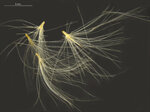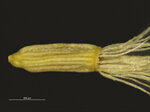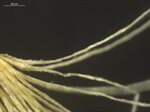Taxonomy
Baccharis halimifolia L., Sp. Pl. 2: 860. 1753.Common synonyms
Conyza halimifolia (L.) Desf., Tabl. École Bot. 97. 1804; Baccharis cuneifolia Moench, Methodus (Moench) 574. 1794.Common name
Baccharis, groundselbush, groundseltree, saltbush, sea myrtle, waterbrush
Description
Fertile part of fruit 1.25-2 mm long, 0.3-0.6 mm wide, in side view mostly +/- equal thickness (cylindrical), widest in upper part (obovoid) or widest in the middle, +/- straight, the upper (apical) end narrowing or suddenly cut off (truncate), in cross-section round (terete), basal scar (carpopodium) central, beak (=thinner sterile stalk between seed and pappus) absent, wings absent, fruit surface (between ribs if any) light brown or straw, smooth (except at cellular level), with no hairs (glabrous) (by misinterpretation) or glands or glandular hairs, thickened margin absent, longitudinal ribs present, 6-10, their surfaces smooth, with no hairs (glabrous), wilted flower mostly absent.
Pappus type bristles / hairs, pappus elements all +/- similar, up to 8-11 mm long, in several rows, number of pappus elements eleven or more, pappus position central on upper end of fruit, persistent, the individual bristles smooth, rarely rough / serrated (barbellate), +/- equal width along length, white / translucent.
Notes: Glands are present on the fruit surface but they are few and concentrated towards the basal part of the fruit. The pappus is probably build to be persistent but pappus hairs are easily pulled off individually or in groups. The teeth on the pappus bristles are small and may be hard to see.
Ecology
Pioneer shrub, highly invase due to prolific, extremely easliy wind-dispersed fruits. Tolerant of wet conditions, salinity and fire. Found especially on beaches and salt marshes, but also inland habitats if moist enough, including ditches and roadsides, but not a crop weed.
Native range
Canada, USA, Mexico, Bahamas, Cuba.
Introduced range
United Kingdom, Netherlands, Belgium, France, Spain, Italy, Georgia, Australia, New Zealand.
Weed status within Australia
NSW Class 2 Regionally Prohibited or Class 3 Regionally Controlled Weed; Qld Restricted Invasive Plant Cat. 3; NT Category C.
Past interceptions (Australia): origins
Canada, United States, Mexico, Argentina, Spain, Belgium, Germany, Thailand, Japan.
Other or unidentified species of the genus also from Colombia, Ecuador, France, Slovakia, Ukraine, Malaysia.
Past interceptions (Australia): commodities
New vehicles.
Other or unidentified species of the genus also in/on machinery and parts, fresh fruit, cut flowers, containers, bird seed.


